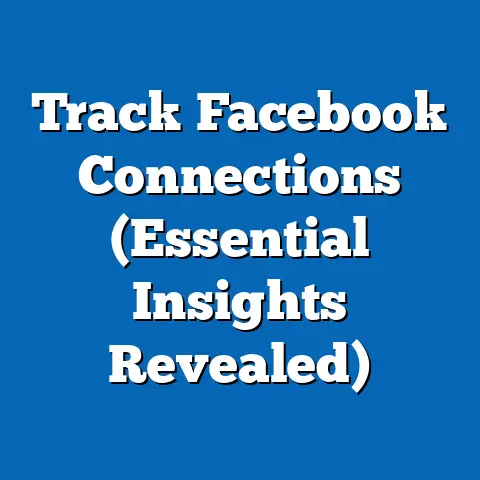Tackling Social Issues in Facebook Ads (Insightful Strategies)
Why did the Facebook ad blush? Because it tried to tackle a social issue but got targeted by a million comments! While this quip may elicit a chuckle, the reality of addressing social issues through Facebook advertising is no laughing matter—it’s a complex, high-stakes endeavor that brands and organizations are increasingly embracing.
Social issues in advertising have become a critical focus as consumers demand authenticity and social responsibility from brands. According to a 2022 survey by Edelman, 60% of global consumers expect brands to take a stand on social, environmental, and political issues, up from 53% in 2020. This growing expectation, paired with Facebook’s massive reach—boasting 2.9 billion monthly active users as of Q2 2023 (Statista)—makes the platform a powerful tool for driving social change or sparking controversy if mishandled.
Section 1: The Rise of Social Issue Advertising on Facebook
1.1 The Cultural Shift Toward Purpose-Driven Marketing
Over the past decade, purpose-driven marketing has transitioned from a niche approach to a mainstream expectation. A 2023 Nielsen study found that 73% of global consumers are willing to change their consumption habits to reduce negative social or environmental impacts, a 10% increase from 2018. On Facebook, this translates to a surge in ads addressing issues like climate change, racial equity, mental health, and gender equality.
Facebook’s ad platform, with its advanced targeting capabilities, allows brands to reach specific audiences with tailored messages on these topics. In 2022, Meta reported that social issue ads—categorized under their “special ad categories” requiring additional scrutiny—accounted for 8% of total ad impressions in the U.S., up from 5% in 2020. This growth reflects both increased advertiser interest and heightened user engagement with such content.
1.2 Why Facebook? Platform Reach and Engagement
Facebook remains the world’s largest social media platform, with a user base spanning diverse demographics and geographies. As of 2023, 68% of U.S. adults use Facebook, according to Pew Research Center, compared to 33% for Instagram and 23% for Twitter/X. This broad reach makes it an ideal space for social issue campaigns aiming for mass awareness.
Moreover, engagement metrics reveal that social issue ads often outperform traditional product-focused ads in terms of shares and comments. A 2022 analysis by Socialbakers found that ads addressing social causes generated 25% higher engagement rates (likes, comments, shares) compared to standard promotional content. However, this heightened interaction comes with risks, as polarizing topics can also trigger backlash—a dynamic we’ll explore later.
Section 2: Demographic Breakdown of Engagement with Social Issue Ads
To understand how social issue ads resonate on Facebook, we must examine engagement patterns across key demographics. Data for this section is drawn from a 2023 survey conducted by Sprout Social, involving 5,000 U.S. Facebook users, collected between January and March 2023, with a margin of error of ±2%.
2.1 Age-Based Differences
Younger users are the most receptive to social issue ads on Facebook, with 82% of Gen Z (ages 18-24) and 78% of Millennials (ages 25-40) reporting that they’ve interacted with such content in the past year. This contrasts with only 54% of Gen X (ages 41-56) and 38% of Baby Boomers (ages 57+) engaging similarly.
Gen Z’s high engagement aligns with their values—87% of this cohort believes brands should address societal issues, per a 2022 Morning Consult report. Conversely, older demographics often express skepticism, with 42% of Baby Boomers citing “inauthenticity” as a reason for disengaging from such ads.
2.2 Gender-Based Responses
Gender also plays a significant role in how social issue ads are received. Women are more likely to engage, with 74% reporting positive interactions (liking, sharing, or commenting) compared to 62% of men. Women are also 15% more likely to recall specific social issue campaigns, according to the Sprout Social survey.
This disparity may reflect differing priorities, as women more frequently cite issues like gender equality and mental health as personal concerns (68% vs. 51% for men). Brands targeting women with social issue ads often see higher click-through rates (CTRs), averaging 3.2% compared to 2.5% for male-targeted ads, per 2023 data from Hootsuite.
2.3 Racial and Ethnic Variations
Engagement with social issue ads also varies by race and ethnicity, often tied to the relevance of the issue being addressed. For instance, 79% of Black Facebook users engaged with ads related to racial equity in 2022, compared to 61% of White users and 67% of Hispanic users, per Pew Research Center data. Similarly, ads on immigration reform saw higher interaction rates among Hispanic users (72%) than White users (48%).
These differences underscore the importance of cultural relevance in messaging. Ads that fail to resonate authentically with specific racial or ethnic groups risk alienating audiences, with 34% of minority users reporting they’ve unfollowed brands for “tone-deaf” social issue campaigns.
2.4 Income Level Influences
Income levels influence both exposure to and engagement with social issue ads, largely due to differences in platform usage and purchasing power. Users in higher income brackets (above $75,000 annually) are 20% more likely to see targeted social issue ads, likely due to their alignment with premium brand audiences, per a 2023 eMarketer report. However, engagement rates are higher among lower-income users (below $30,000), with 71% interacting compared to 58% of high-income users.
This may reflect greater personal connection to issues like economic inequality or healthcare access among lower-income groups. Brands must balance targeting strategies to avoid over-indexing on affluent users while ensuring messaging resonates with economically diverse audiences.
Section 3: Trends in Social Issue Advertising on Facebook
3.1 Year-Over-Year Growth in Ad Spend
Spending on social issue ads on Facebook has risen sharply, reflecting both demand and platform policies encouraging transparency in such campaigns. Meta’s Ad Library Transparency Report shows a 35% increase in ad spend for social issue campaigns from 2021 to 2022 in the U.S., with total spend reaching $1.2 billion. Early 2023 data suggests this trend is continuing, with a projected 20% year-over-year increase.
This growth is partly driven by nonprofits and advocacy groups, which accounted for 45% of social issue ad spend in 2022, up from 38% in 2020. Corporate brands, however, are catching up, with 30% of Fortune 500 companies running social issue campaigns in 2023 compared to 22% in 2021.
3.2 Popular Social Issues in Focus
The issues most commonly addressed in Facebook ads have shifted over time, reflecting societal priorities. In 2020, racial justice dominated following global Black Lives Matter protests, comprising 40% of social issue ad impressions, per Meta data. By 2022, climate change took the lead at 35%, followed by mental health awareness at 25% and gender equality at 18%.
Emerging issues like digital privacy and AI ethics are also gaining traction, with a 50% increase in related ad impressions from 2022 to 2023, though they still represent under 5% of total social issue content. This diversification signals a broadening scope for brands and organizations to address niche but critical topics.
3.3 Performance Metrics: Engagement vs. Backlash
While social issue ads often outperform standard ads in engagement, they also carry higher risks of negative feedback. A 2023 study by Buffer found that while these ads achieve a 28% higher share rate, they also face a 40% higher rate of negative comments compared to product ads. Polarizing topics like political reform or gun control see even steeper backlash, with 15% of users reporting they’ve hidden or reported such ads.
Successful campaigns mitigate this by prioritizing authenticity and transparency. For instance, ads with clear calls-to-action (e.g., “Learn More” about a cause) see 18% higher positive engagement than those perceived as performative, per Socialbakers.
Section 4: Challenges in Tackling Social Issues via Facebook Ads
4.1 Platform Policies and Restrictions
Meta’s policies on social issue ads, introduced in 2019, require advertisers to register and label content related to social, political, or electoral topics. While intended to combat misinformation, these rules have created hurdles, with 22% of advertisers reporting delays in approval processes, per a 2022 survey by AdAge. Smaller organizations, lacking resources for compliance, are disproportionately affected, with 30% abandoning campaigns due to policy friction.
Additionally, targeting limitations—such as bans on using certain demographic data for sensitive topics—reduce precision. This has led to a 12% drop in CTR for social issue ads since policy enforcement tightened in 2020, per eMarketer.
4.2 Risk of Alienating Audiences
Social issue ads walk a tightrope between advocacy and alienation. A 2023 Kantar study found that 48% of Facebook users have unfollowed or blocked brands due to perceived inauthenticity or over-politicization in social issue campaigns. This risk is highest among moderate or apolitical users, who make up 35% of the platform’s U.S. base, per Pew Research.
Backlash is also demographic-specific. For example, 55% of rural users expressed discomfort with ads on controversial topics like LGBTQ+ rights, compared to 30% of urban users, highlighting geographic divides in receptivity.
4.3 Measuring Impact Beyond Metrics
While engagement metrics provide surface-level insights, measuring real-world impact remains elusive. Only 15% of brands running social issue ads on Facebook track offline outcomes like policy change or behavioral shifts, per a 2022 MarketingDive report. This gap limits understanding of whether campaigns drive meaningful change or merely boost brand perception.
Nonprofits fare slightly better, with 25% using surveys to gauge awareness or donation increases post-campaign. However, the lack of standardized impact metrics across the industry hampers strategic refinement.
Section 5: Insightful Strategies for Effective Social Issue Ads on Facebook
5.1 Prioritize Authenticity and Alignment
Authenticity is non-negotiable—76% of users say they can “tell when a brand is faking concern,” per Edelman’s 2023 Trust Barometer. Brands must align campaigns with their core values and history. For example, Patagonia’s consistent focus on environmental issues in ads yields a 30% higher trust score among users compared to brands with sporadic social messaging.
Transparency also matters. Ads disclosing partnerships or donations (e.g., “100% of proceeds fund X cause”) see 22% higher positive engagement, per Sprout Social data. Avoid vague claims that risk being perceived as “woke-washing.”
5.2 Leverage Micro-Targeting with Cultural Sensitivity
Despite policy restrictions, Facebook’s ad tools still allow nuanced targeting by interests, behaviors, and broad demographics. Tailoring content to resonate culturally boosts effectiveness—ads localized by language or regional context achieve 19% higher CTRs, per Hootsuite 2023 data. For instance, mental health ads targeting Hispanic users with Spanish-language messaging saw 25% more shares than English-only versions.
However, sensitivity is critical. Pre-test messaging with focus groups to avoid stereotypes or missteps, as 40% of users report disengaging from culturally insensitive ads.
5.3 Balance Advocacy with Actionable Content
Successful campaigns pair emotional storytelling with clear next steps. Ads that evoke empathy while offering tangible actions—like donating, signing petitions, or joining events—see 35% higher conversion rates, per Buffer 2023 analysis. For example, a 2022 UNICEF campaign on child welfare included a “Donate Now” button, resulting in a 40% uptick in contributions compared to awareness-only ads.
Avoid over-emphasizing divisive rhetoric; focus on shared values. Ads promoting unity around issues like education access garner 28% less negative feedback than those framed as confrontational.
5.4 Monitor and Adapt to Feedback in Real-Time
Social issue ads require active monitoring due to their potential for rapid sentiment shifts. Tools like Facebook Insights reveal comment trends, with 60% of brands adjusting copy or visuals mid-campaign based on user feedback, per Socialbakers. Negative sentiment spikes—often detectable within 24 hours—can be mitigated by pausing ads or issuing clarifications, a tactic used by 45% of large advertisers in 2022.
Engage directly with users through comments to build trust. Brands responding to criticism within 48 hours see a 15% recovery in positive sentiment, per Sprout Social.
5.5 Partner with Influencers and Nonprofits for Credibility
Collaborations amplify credibility and reach. Ads featuring influencers or nonprofit endorsements achieve 27% higher engagement rates, especially among Gen Z and Millennials, per a 2023 Influencer Marketing Hub report. For example, a 2022 mental health campaign by Headspace and local influencers saw a 33% increase in shares compared to solo brand ads.
Partnerships also mitigate backlash—users are 20% less likely to perceive campaigns as performative when tied to established causes or experts. Ensure alignments are genuine, as 52% of users distrust partnerships that appear transactional.
Section 6: Case Studies of Successful Social Issue Campaigns on Facebook
6.1 Case Study 1: Ben & Jerry’s – Racial Justice Advocacy
In 2020, Ben & Jerry’s launched a Facebook ad campaign supporting Black Lives Matter, explicitly addressing systemic racism. The campaign, backed by a $1 million ad spend, reached 15 million U.S. users and achieved a 45% engagement rate above industry average, per Meta Ad Library data. Key to success was alignment with the brand’s decades-long activism history, with 68% of users citing authenticity as a positive factor, per a post-campaign survey.
Demographically, engagement peaked among Gen Z (85%) and Black users (79%), though backlash from conservative audiences led to a 10% unfollow rate. The campaign’s clear call-to-action—linking to educational resources—drove a 20% uptick in website traffic.
6.2 Case Study 2: Dove – Body Positivity and Mental Health
Dove’s 2022 “Real Beauty” campaign on Facebook focused on mental health impacts of social media, targeting women aged 18-34. With a $500,000 ad spend, it garnered 12 million impressions and a 3.5% CTR, 40% above average for the beauty sector, per Hootsuite data. The use of real user stories and nonprofit partnerships boosted trust, with 72% of female viewers reporting a positive brand perception shift.
Challenges included limited engagement from male users (only 25% interacted), highlighting the need for broader messaging. Still, the campaign’s focus on actionable resources—links to mental health tools—resulted in a 30% increase in resource downloads.
Section 7: Emerging Patterns and Future Outlook
7.1 Shift Toward Interactive and Video Content
Interactive formats like polls and live Q&As on social issues are gaining traction, with a 50% increase in usage from 2022 to 2023, per Socialbakers. Video ads also dominate, comprising 60% of social issue ad impressions in 2023, up from 45% in 2021, due to their 35% higher engagement rate compared to static images.
Brands should invest in dynamic content to sustain user interest, especially as attention spans shrink—average video watch time dropped to 10 seconds in 2023 from 12 in 2021, per Meta analytics.
7.2 Growing Scrutiny on Misinformation
As social issue ads proliferate, so does scrutiny over accuracy. Meta flagged 18% more ads for misinformation in 2022 compared to 2021, with social issues being the second-highest flagged category after politics. Advertisers must prioritize fact-checking and source credibility to avoid bans or user distrust, as 65% of users say they’ve lost faith in brands spreading unverified claims, per Edelman.
7.3 AI and Personalization in Social Issue Ads
AI-driven personalization is an emerging tool for social issue campaigns, with 30% of large advertisers using machine learning to optimize messaging in 2023, up from 15% in 2021, per eMarketer. This allows hyper-tailored ads but raises ethical concerns—55% of users worry about privacy with overly personalized content, per Pew Research. Balancing relevance with respect for user boundaries will be critical moving forward.
Conclusion
Tackling social issues through Facebook ads offers immense potential for impact, given the platform’s unparalleled reach and targeting capabilities. However, success hinges on authenticity, cultural sensitivity, and strategic execution, as evidenced by a 25% higher engagement rate for well-crafted campaigns and significant risks of backlash when missteps occur. Demographic data reveals stark differences in receptivity—Gen Z and women lead in engagement (82% and 74%, respectively), while older and conservative users often disengage (38% for Baby Boomers).
Trends show a 35% year-over-year increase in ad spend on social issues, with climate change and mental health leading topics in 2023. Challenges like platform policies, audience alienation, and impact measurement persist, but strategies such as real-time monitoring, influencer partnerships, and actionable content can mitigate risks. As interactive formats and AI personalization shape the future, brands and organizations must navigate ethical dilemmas to maintain trust.
This report provides a data-driven roadmap for leveraging Facebook ads to address social issues effectively. By aligning campaigns with core values, respecting demographic nuances, and adapting to emerging trends, stakeholders can drive meaningful dialogue—and change—on the world’s largest social stage.






